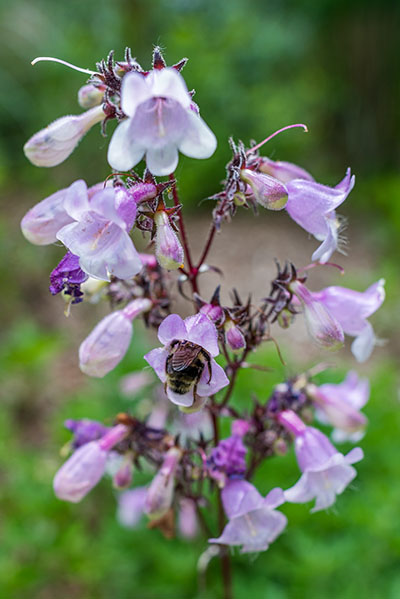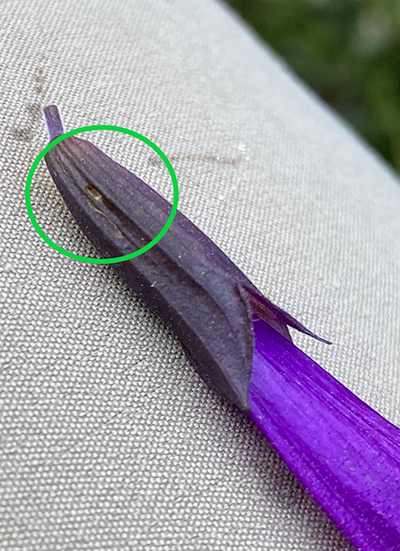Garden Talk
Pollinator Syndromes
By April Stradley
Historic Gardens Horticulturist

As a horticulturist at a public garden, I have the opportunity for excellent people watching as I work in the shrubs or planting beds. As folks pass by, the sound of their conversation floats around me, blending with bird song and insect whirring to become a very pleasant soundtrack of incoherent murmuring. Folks never linger long enough for me to make any sense of their words. We are fortunate here at Sarah P. Duke Gardens to host visitors from all over the world, and from all walks of life--even though I do not always understand the languages they're speaking, it is a truly lovely soundtrack to my work day.
The plants of the Gardens also use a language of sorts to communicate with potential pollinators. When we humans admire redbud flowers (Cercis canadensis), we might not realize how much subtext is present in their appearance for those who know how to read the secret code of the flowers. Botanists call this language a pollinator syndrome.
We’re used to seeing the word “syndrome” in a medical context, referring to a group of symptoms that routinely occur together. When discussing pollinator syndromes, we use the word in its more literal sense. A pollinator syndrome refers to a suite of traits that developed as plants and their pollinators coevolved and adapted to each other’s changes over time.
Some examples of pollinator syndromes are flower color, shape, scent, the abundance of pollen, and the presence of nectar. With the native coral honeysuckle vine, we see a red color, and a funnel-like flower shape hiding ample nectar deep inside the funnel. These traits correlate with pollinators like hummingbirds and butterflies, which both have long proboscises that can reach the depths of the funnel-shaped flower. Pollinator syndromes associated with bees are bright colors like yellow, an abundance of nectar and sticky pollen, and an open flower shape that provides a kind of landing platform or “runway” for the bees to land on. For example, flowers of the purple Catawba rosebay (Rhododendron catawbiense) are wide, open, and display dots on the petals, which guide the bees to the nectar. As they follow the nectar guide to the center of the flower, their backs brush against the anthers and become dusted with pollen. The bee gets the nectar reward, and the flower accomplishes its own biological imperative to spread its pollen. Everyone wins.
As with any good science, the theories of pollinator syndromes can be complicated, and we learn more as theories are challenged. However, in general, I find these traits serve as useful heuristics for classifying flowers into certain groups. The concept can be especially handy for folks designing a pollinator garden based on the fauna they have already identified in their landscapes. Some folks want to support native bees, or attract hummingbirds, or provide much-needed food for migrating monarch butterflies. Rather than spending days researching what can quickly become an overwhelming amount of flora and fauna, one can apply the pollinator syndrome heuristic to organize a plant palette into manageable groups. In general, it is relatively safe to assume that wide, cup-shaped or flat flowers with nectar guides like coneflower (Echinacea), blanket flower (Gaillardia) and beardtongues (Penstemon) are going to support bees. Butterflies are likely to be found pollinating funnel or fuzzy flowers like columbine (Aquilegia), blazing star (Liatris spicata) and, of course, milkweed (Asclepias). Beetles might be found on bowl-shaped and highly fragrant flowers. The southern magnolia (Magnolia grandifolia) is an example of a beetle pollinated flower. Flies prefer a flower with a fragrance that a human nose might find unpleasant. Plants utilizing wind as their pollinator, like grasses and pine trees, will have inconspicuous, non-fragrant inflorescences.

However, the pollinating fauna of this world don’t always follow the rules. Insects and animals are opportunistic and clever enough to manipulate the system. A hummingbird will sip from a red plastic feeder as readily as from a woodland pinkroot (Spigelia marilandica). Bees can’t seem to get enough magnolia nectar, even though magnolias evolved their flower anatomy before bees existed. Carpenter bees are too big and their proboscises too short to reach inside some of the nectar rich, funnel-shaped flowers, so instead they can be observed landing on the side of the petals and chewing holes to reach the nectar inside. For folks seeking out plants that can support a variety of insects and animals, this type of opportunistic foraging is a good thing. Perennials like Joe Pye weed (Eutrochium purpureum), for example, are visited by several different pollinators, including bees, butterflies and beetles.
As spring unfolds here in the Piedmont, the buzz in Sarah P. Duke Gardens is already on the rise. Visitors from all over the world are beginning to stroll our paths, adding the sound of their laughter and chitchat to the chirp, buzz and hum of birds, bees and flower flies. Pollinators are already busy working amongst the cherry (Prunus sp.), azalea (Rhododendron sp.) and viburnum blossoms. What plants in your garden are being visited by awakening bees and butterflies? How many different types of pollinators can you spot on a single plant? Do you notice any rogue fauna breaking the “rules” of the pollinator syndromes? No matter what language you use, I hope you will add it to the beautiful soundtrack of Sarah P. Duke Gardens this spring!
Photos from top: A honeybee covered in pollen explores a red echinacea flower in the Charlotte Brody Discovery Garden, by William Hanley; a bumblebee gathers nectar in a cluster of purple penstemon flowers, by Cathi Bodine; detail of an anise-scented sage flower (Salvia guaranitica ‘Black and Bloom’) with a tiny hole chewed through the sepal near the base of the flower by a bee, by April Stradley.






